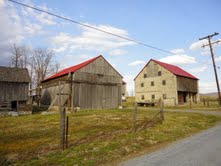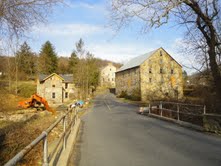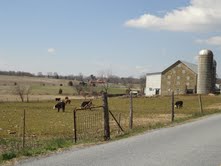by Brenda Barrett
Editor’s Note: This post was originally published in the Living Landscape Observer and appears here with the permission of the author and founder of that publication, Brenda Barrett. We appreciate Brenda’s contributions and reporting on this subject.
Even in a state famous for its agricultural landscapes, the Oley Valley in southeast Pennsylvania is an exceptional place. Located in a in a bowl-shaped valley flanked by the forested hills of the Reading Prong and underlain by limestone, the region is drained by two small creeks, the Manataway and the smaller Monocacy. English Quakers, French Huguenots, and Palatine farmers from Switzerland and Germany settled in the valley as early as 1725 in search of religious freedom and good farmland. They found both, producing an 18th-century pattern of farmsteads, fields, and villages that has marked the landscape ever since.
The region’s resources and topography also fostered a mix of early industries including gristmills and other milling operations, iron furnaces, charcoal production, and lime kilns. Today these industries are marked by an occasional ruin; it is agriculture that is the persistent land use, its success ensured by the especially rich limestone soils and an early tradition of nourishing those soils by with lime burned from local stone. The valley’s architectural heritage is primarily Germanic-influenced farmsteads with a high proportion of limestone houses, a wide variety of early barns, and intact outbuildings, many of them stone, some even featuring early clay tile roofs. The valley has more than 150 extant farm complexes including dozens of 18th century farm buildings, a covered bridge, burial grounds, and gristmills. The land is demarcated by hedgerows, farm fields, and boundaries that on many properties date back to land grants form the time of William Penn.
The Oley Valley is also exceptional in the history of designation and conservation of large landscapes. In 1979, the National Trust for Historic Preservation launched its Rural Project to provide advice, training, and publications to spur preservation activity in rural areas. The goal was to link historic preservation with broader planning and environmental issues. The Oley Valley along with Cazenovia New York were selected as pilot projects for this effort. The trust’s Mid-Atlantic Regional Office, led by Samuel N. Stokes and field rep Elizabeth Watson, coordinated the efforts, but relied on heavily local volunteers to identify the important issues and manage the work. The community formed four committees: a historic resource group, an agricultural group to consider farmland preservation, a visual qualities group, and a natural resource group focusing a on water resources. The inventory work of the historic resource group, advised by noted historic preservation consultant Ellen Beasley, led to the then-radical idea of listing the entirety of Oley Township in the National Register of Historic Places, nearly 25 square miles (comprising the valley; most of the surrounding hills are in separate jurisdictions). Unusual for its time, the nomination documented the landscape characteristics of valley as well as the rich architectural and historic significance. On March 11, 1983, the Oley Valley was officially listed in the National Register (Editor’s Note – PHMC Key#000796). Although written before the National Park Service (NPS) had adopted guidelines for recognizing a Rural Historic District, the township’s nomination demonstrates that the region certainly met the definition:
“A geographical area that historically has been used by people, or shaped or modified by human activity, occupancy, or intervention, and that possesses a significant concentration, linkage, or continuity of areas of land use, vegetation, buildings, structures, roads and waterways, and natural features.” (NPS 1989)
Finally, the Oley Valley is exceptional because over the last thirty years the community has continued its steadfast efforts to preserve the rural qualities of the landscape. Recent research by Zachary Pyle in his master’s thesis for an M.S. in Landscape architecture, A Case Study of Overall Historic Character and Preservation Initiatives: Oley Township Historic District (Penn State 2012), documents that the qualities identified as historically significant in 1983 nomination can be found in Oley’s landscape today. He also confirms how critical interweaving historic preservation, agricultural conservation, good land use planning, and environmental protection has been to saving a whole landscape. And the National Trust’s instincts were correct: only the community’s hard work could have made it happen. Thanks to Zachary Pyle, we now have an inspirational lesson for everyone who cares about conserving a sense of place.
Grace Note
On April 20, 2013 the Oley Valley Heritage Association celebrated the thirty-year anniversary of its founding and the National Register listing with a family-style roast beef and turkey dinner and a presentation by Phoebe Hopkins, a native of the valley who wrote the original nomination and coordinated the National Trust’s work there, and Zachary Pyle. Elizabeth Watson, who journeyed back for the occasion, reflected afterward about the long-term success of this rural heritage project, “‘ When the student is ready, the teacher will appear.’ But which was the student, and which was the teacher? Phoebe insists that without the National Trust for Historic Preservation’s recruitment of Oley as a demonstration community, this all might never have happened. Surely, though, the National Trust – and all who care about landscape protection – gained just as much. And perhaps both the trust and the community had a teacher – the landscape itself. The Oley Valley is so overwhelmingly lovely, it commanded us all to pay attention.”
Brenda Barrett is the editor of the Living Landscape Observer, a site providing commentary on landscape scale conservation, historic preservation and sustainable communities. She served as the National Coordinator for Heritage Areas for the US National Park Service and has lead programs in state conservation and heritage agencies. She is an expert member of the ICOMOS International Committee on Cultural Landscapes.
Comment Policy
PHMC welcomes and encourages topic-related comments on this blog. PHMC reserves the right to remove comments that in PHMC’s discretion do not follow participation guidelines.
Commenters and Comments shall be related to the blog post topic and respectful of others who use this site.
Commenters and Comments shall not: use language that is offensive, inflammatory or provocative (this includes, but is not limited to, using profanity, obscene, or vulgar comments); disparage other commenters or people; condone illegal activity; identify the location of known or suspected archeological sites; post personal information in comments such as addresses, phone numbers, e-mail addresses or other contact details, which may relate to you or other individuals; impersonate or falsely claim to represent a person or an organization; make any commercial endorsement or promotion of any product, service or publication.
If you would like to comment on other topics not related to this blog post but related to PHMC, please fill out the PHMC Contact Us Form.



Leave a Reply